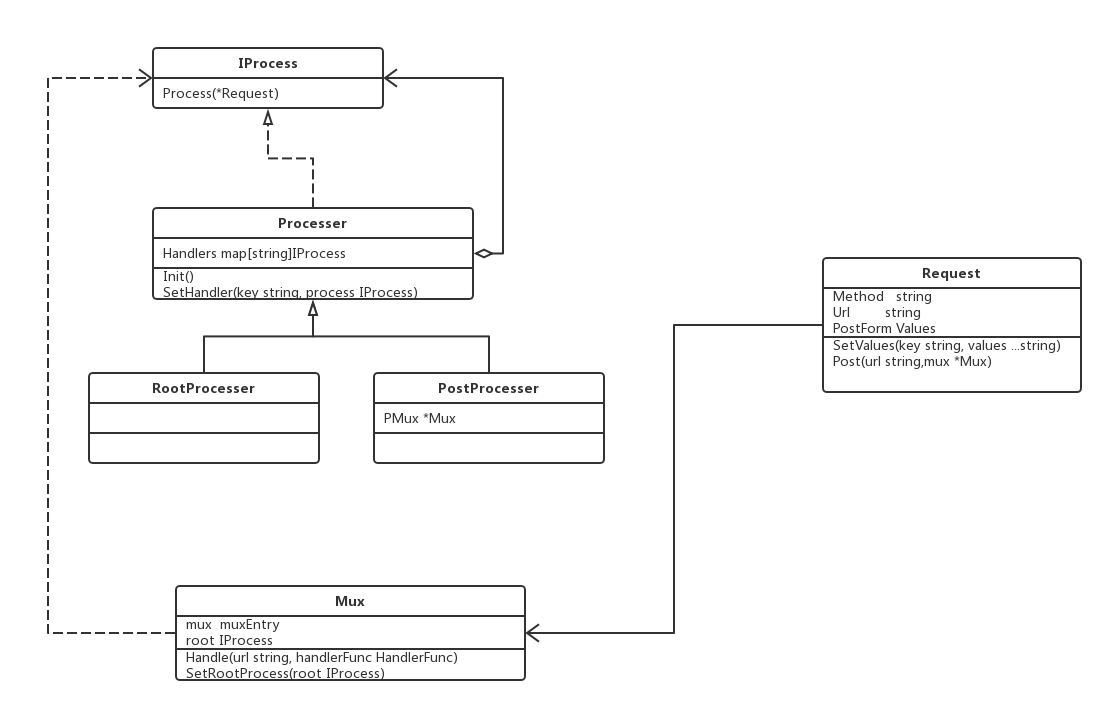责任链模式
发布时间 :
阅读 :
Chain of Responsibility Pattern
责任链模式为请求创建了一个接收者对象的链。处理请求的对象是一系列链条,或者一个集合。每个处理节点都保存有其他处理节点的引用。接收到请求的时候,会判断该请求是否需要自己处理,处理完毕传给下一个处理节点,有点像流水线作业。
例子
让我举一个复杂一点的例子。我就不用链条的形式来写了,我用一个map来保存处理器的引用。
单机情况下模拟一个Request的发送。
结构如下:

这个系统中,定义一个IProcess接口,每一个处理节点都应该实现这个接口。
创建一个Processer结构实现这个接口,这个结构也作为父类被RootProcesser和PostProcesser结构继承。
RootProcesser作为根节点,它的职责是把收到的请求,根据请求的方法传递给相应方法的处理节点,这里只有Post方法。
PostProcesser收到请求后,根据Url和多路复用器,将请求传递给相应Url的处理函数。
处理函数在Mux结构中注册,以便被调用。
下面是关于Request的定义
1
2
3
4
5
6
7
8
9
10
11
12
13
14
15
16
17
18
19
20
21
22
23
24
25
26
27
28
29
30
| package chainofresponsibility
type Values map[string][]string
type Request struct {
Method string
Url string
PostForm Values
}
func MakeRequest() *Request {
r := Request{}
r.PostForm = make(Values)
return &r
}
func SendRequst(request *Request,mux *Mux){
mux.root.Process(request)
}
func (this *Request) SetValues(key string, values ...string) {
this.PostForm[key] = append(this.PostForm[key], values...)
}
func (this *Request) Post(url string,mux *Mux) {
this.Method = "POST"
this.Url=url
SendRequst(this,mux)
}
|
下面是处理器和多路复用器的定义
1
2
3
4
5
6
7
8
9
10
11
12
13
14
15
16
17
18
19
20
21
22
23
24
25
26
27
28
29
30
31
32
33
34
35
36
37
38
39
40
41
42
43
44
45
46
47
48
49
50
51
52
53
54
55
56
57
58
59
60
61
62
63
64
65
66
67
68
69
70
71
72
73
74
75
76
77
78
| package chainofresponsibility
type IProcess interface {
Process(request *Request)
}
type HandlersCollection map[string]IProcess
type Processer struct {
Handlers HandlersCollection
}
func (this *Processer) SetHandler(key string, process IProcess) {
this.Handlers[key] = process
}
func (this *Processer) Init() {
this.Handlers = make(HandlersCollection)
}
type RootProcesser struct {
Processer
}
func (this *RootProcesser) Process(request *Request) {
this.Handlers[request.Method].Process(request)
}
func newRootProcesser() *RootProcesser {
root := new(RootProcesser)
root.Processer.Init()
return root
}
type PostProcesser struct {
Processer
PMux *Mux
}
func newPostProcesser(mux *Mux) *PostProcesser {
post := new(PostProcesser)
post.Processer.Init()
post.PMux = mux
return post
}
func (this *PostProcesser) Process(request *Request) {
this.PMux.mux[request.Url](request)
}
type HandlerFunc func(request *Request)
type muxEntry map[string]HandlerFunc
type Mux struct {
mux muxEntry
root IProcess
}
func (this *Mux) Handle(url string, handlerFunc HandlerFunc) {
this.mux[url] = handlerFunc
}
func (this *Mux) SetRootProcess(root IProcess) {
this.root = root;
}
func NewMux() *Mux {
mux := Mux{}
mux.mux = make(muxEntry)
root := newRootProcesser()
post := newPostProcesser(&mux)
root.SetHandler("POST", post)
mux.root = root;
return &mux
}
|
下面是main
1
2
3
4
5
6
7
8
9
10
11
12
13
14
15
16
17
18
19
20
21
22
23
24
25
26
27
| package main
import (
"projects/DesignPatternsByGo/behavioralPatterns/chainofresponsibility"
"fmt"
)
func Login(request *chainofresponsibility.Request){
username := request.PostForm["username"][0]
password := request.PostForm["password"][0]
fmt.Println(username)
fmt.Println(password)
}
func main(){
mux := chainofresponsibility.NewMux()
mux.Handle("login",Login)
req := chainofresponsibility.MakeRequest()
req.Method="POST"
req.SetValues("username","111")
req.SetValues("password","222")
req.Post("login",mux)
}
|
优点
- 降低耦合度。它将请求的发送者和接收者解耦。
- 简化了对象。使得对象不需要知道链的结构。
- 增强给对象指派职责的灵活性。通过改变链内的成员或者调动它们的次序,允许动态地新增或者删除责任。
- 增加新的请求处理类很方便。
缺点
- 不能保证请求一定被接收。
- 系统性能将受到一定影响,而且在进行代码调试时不太方便,可能会造成循环调用。
- 可能不容易观察运行时的特征,有碍于除错。
转载请注明来源,欢迎对文章中的引用来源进行考证,欢迎指出任何有错误或不够清晰的表达。可以邮件

